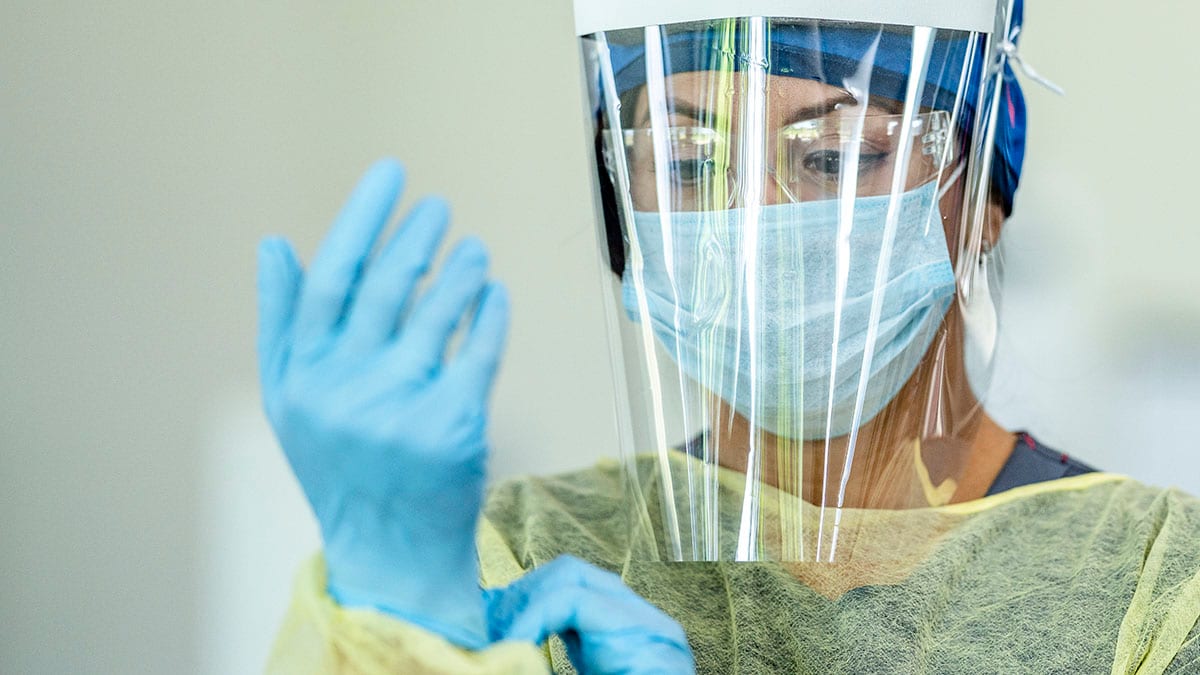Purpose
- Identify the types of PPE healthcare personnel would use if fentanyl is reasonably suspected to be present.
- Identify best practices for decontamination if healthcare personnel come into contact with illicit fentanyl.

Personal Protective Equipment (PPE)
Healthcare personnel may be at increased risk of exposure to illicit fentanyl if small amounts of fentanyl products are visible on the patient, clothing, or possessions. In this case, healthcare personnel would use the following PPE:
- At least an N100, R100, or P100 disposable filtering facepiece respirator 1or a respirator that provides a higher level of protection
- Face and eye protection that may include goggles or a faceshield when wearing a filtering facepiece respirator2
- Powder-free nitrile gloves3
- Wrist/arm protection, such as sleeve covers, that would cover skin which may not be covered by usual clothing or uniform such as gowns or coveralls
Risks
It is important to recognize that the healthcare personnel’s potential for exposure may change during the patient encounter or stay in a healthcare facility, and PPE for these purposes should be adjusted accordingly. For situations in which no fentanyl products are visible on the patient, clothing, or possessions, the PPE noted above would not be recommended. Additionally, the PPE noted above would no longer be recommended if decontamination was performed as recommended below.
In all cases, employers should identify hazards to which their personnel might be exposed and provide appropriate PPE to protect them. All PPE should be used in accordance with the Occupational Safety and Health Administration (OSHA) PPE standard (29 CFR 1910.132). When required, respirator use should be in the context of a comprehensive respiratory protection program in accordance with the OSHA Respiratory Protection Standard (29 CFR 1910.134) and other requirements. Healthcare personnel who need to wear respirators should be medically cleared, trained, and fit-tested for respirator use. Detailed information on respiratory protection programs, including fit-testing procedures, can be accessed in OSHA's Respiratory Protection eTool .
Decontamination
Patients who may be contaminated4 and healthcare personnel who come into contact with illicit fentanyl should immediately remove clothing and use soap and water to thoroughly wash and rinse potentially contaminated skin. They should avoid breaking the skin during the decontamination process and they should cover all open wounds. Do not use alcohol-based hand rubs or bleach solutions to clean contaminated skin. All contaminated clothing should be removed, segregated from other laundry, and laundered at the healthcare facility when possible, being careful not to disturb any areas of contamination. Employers should establish policies and staffing to ensure that healthcare personnel shower and change clothing immediately after a potential exposure.
Decontamination of reusable PPE and equipment should be done according to the manufacturer's recommendations. Contaminated single use PPE should be placed in labeled durable 6 mil polyethylene bags and disposed of appropriately.
Laundering (laundry may include bed sheets and blankets, towels, personal clothing, patient apparel, uniforms, scrubs, and gowns) should be done in a manner that minimizes disturbance of any areas of contamination and segregates contaminated laundry, allowing it to be handled safely. Laundering in a healthcare facility should be done in accordance with the Laundry and Bedding section in the CDC Guidelines for Environmental Infection Control in Health-Care Facilities.
Routine cleaning of work surfaces and rooms in healthcare facilities should be done in accordance with the Principles of Cleaning and Disinfecting Environmental Surfaces section of the CDC Guidelines for Environmental Infection Control in Health-Care Facilities. Surfaces suspected or know to be contaminated with illicit fentanyl that are able to be cleaned (such as hard, non-porous surfaces) should first be washed with soap and water as outlined in the Cleaning Housekeeping Surfaces section before using a disinfectant (such as bleach). Any activity which could result in making an unknown contaminant airborne (such as dry sweeping or vacuuming with a standard vacuum) should not be performed. A high-efficiency particulate air (HEPA) filter vacuum should be used when sweeping or vacuuming is required.
- [1] N: not resistant to oil, P: oil proof, R: resistant to oil.
- [2] Faceshields are recommended when additional protection is needed to protect against possible body fluid splashes when wearing filtering facemasks.
- [3] Powder-free nitrile gloves should be worn with a minimum thickness of 5 +/- 2 mil (i.e. 0.127 +/- 0.051 millimeters; 1 mil=0.0254 millimeters), unless manufacturer provides performance breakthrough data for thinner gloves.
- [4] If patient is incapacitated, this should be done for the patient by the healthcare personnel.
